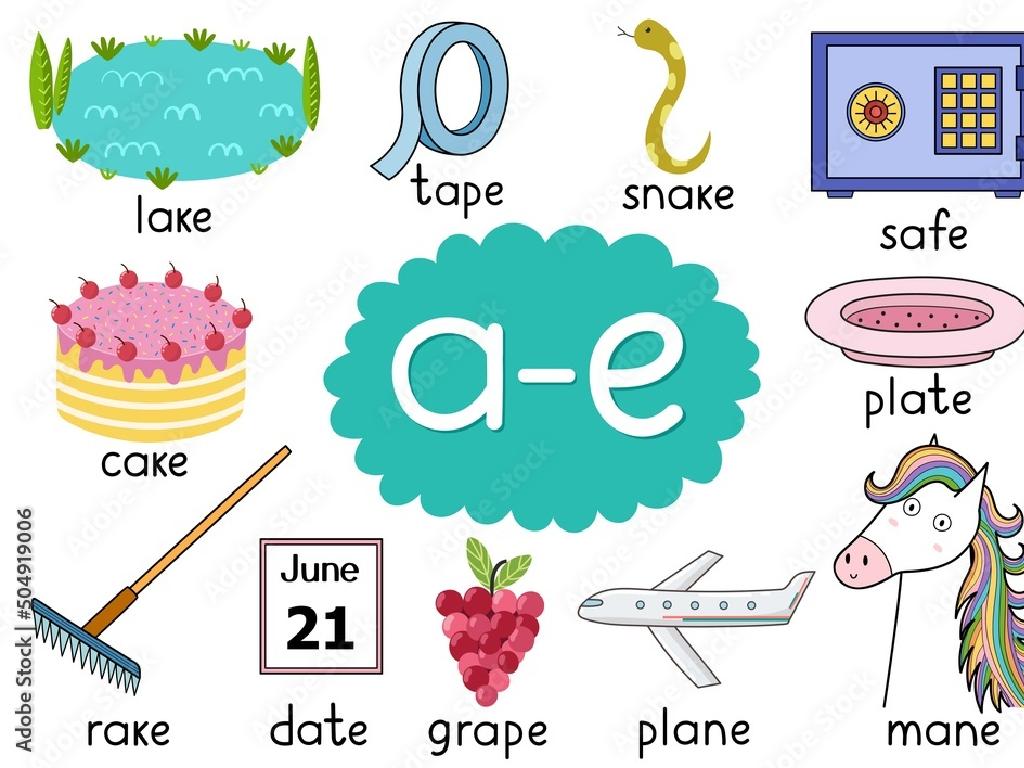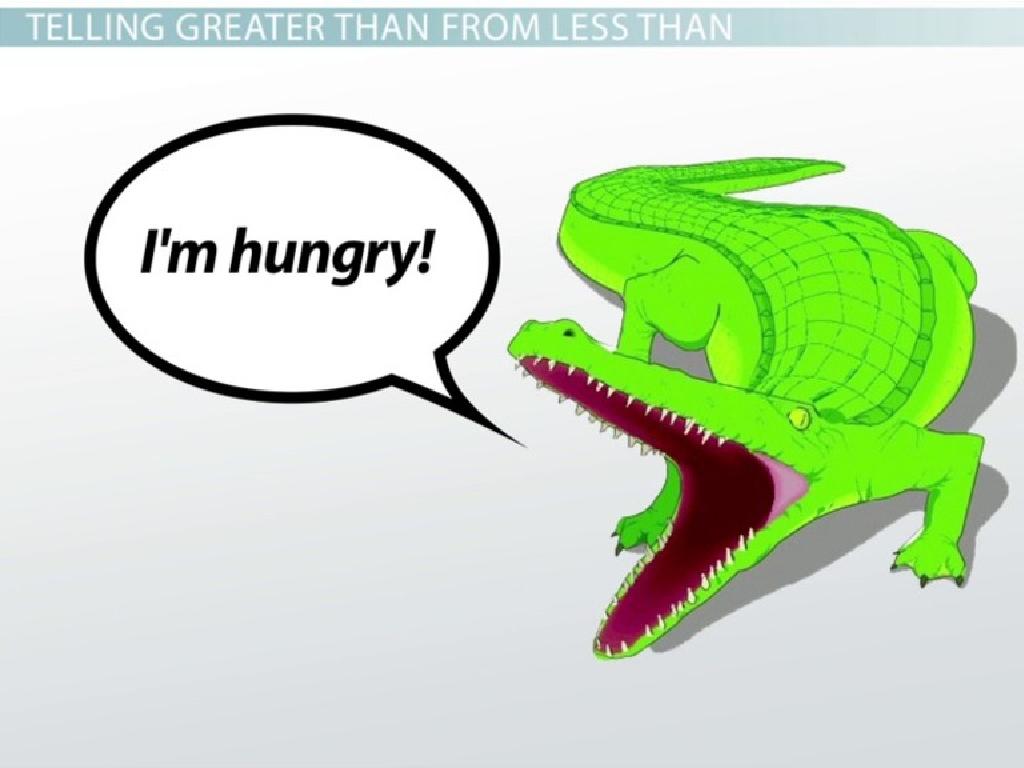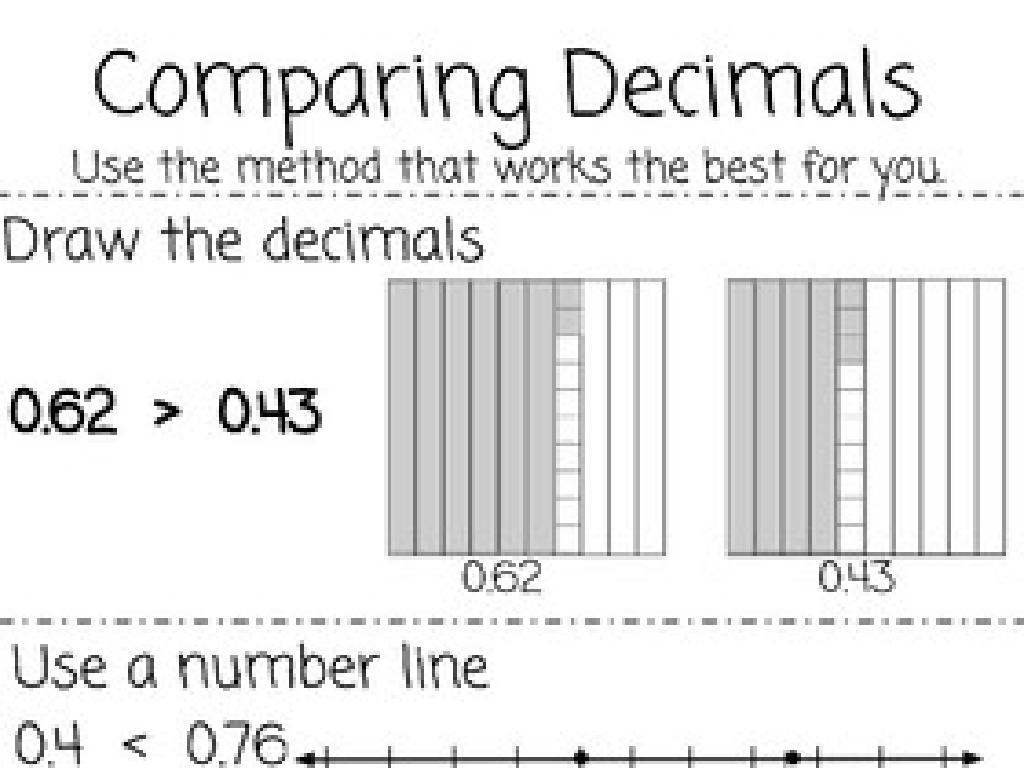Identify Equivalent Expressions Using Strip Models
Subject: Math
Grade: Sixth grade
Topic: Equivalent Expressions
Please LOG IN to download the presentation. Access is available to registered users only.
View More Content
Identifying Equivalent Expressions with Strip Models
– Balance in mathematics
– Equations are like a balance scale, both sides must be equal
– Defining equivalent expressions
– Expressions that simplify to the same value
– Using strip models
– Visual tools representing expressions
– Today’s learning goal
– Recognize expressions that represent the same value
|
This slide introduces the concept of equivalent expressions in the context of maintaining balance in mathematics, akin to a scale. Students will learn that equivalent expressions, although they may look different, will simplify to the same value. Strip models, which are visual representations, will be used to help students understand and identify equivalent expressions. The goal for today’s lesson is for students to become comfortable with using strip models to recognize expressions that represent the same value. Encourage students to think of the strip models as a way to ‘see’ the balance in an equation and to use this method to verify the equivalence of different expressions.
Understanding Mathematical Expressions
– Define a math expression
– A combination of numbers, variables, and operators
– Explore expression components
– Terms are the elements separated by + or -, coefficients are numbers multiplying variables, and variables are symbols representing numbers
– View examples of expressions
– For instance, 3x + 2 and 7 – y are simple expressions
|
This slide introduces the concept of mathematical expressions to sixth-grade students. Begin by defining what a mathematical expression is, emphasizing that it is a mix of numbers, variables, and mathematical operations without an equality sign. Next, explain the different parts of an expression: terms are the building blocks separated by addition or subtraction signs, coefficients are the numerical factors that multiply the variables, and variables are symbols that represent unknown values. Provide examples of simple expressions, such as 3x + 2, where ‘3’ is the coefficient, ‘x’ is the variable, and the expression consists of two terms. Encourage students to identify parts of expressions in class examples and their own work.
Introduction to Strip Models
– What are Strip Models?
– Visual tools for understanding expressions
– Representing expressions visually
– Each strip or part represents a value or variable
– Visualizing equivalence in expressions
– See how different expressions can equal the same value
– Why visualization matters
|
Strip models, also known as bar models, are a visual method for representing mathematical expressions. They help students understand abstract concepts by breaking down expressions into more manageable parts. Each strip or section of the model can represent a different component of an expression, such as a value or a variable. By comparing different strip models side by side, students can easily see how different expressions can represent the same quantity, thus identifying equivalent expressions. Emphasize the importance of visual learning tools in mathematics to enhance comprehension, especially for complex concepts. Encourage students to draw their own strip models for various expressions during practice.
Creating Strip Models for Equivalent Expressions
– Step-by-step strip model creation
– Follow a guided process to make a strip model that represents an algebraic expression.
– Use colors/labels for expression parts
– Assign colors to variables and labels to constants to differentiate elements.
– Class Activity: Build a strip model
– We’ll create a strip model as a class to demonstrate equivalent expressions.
– Understanding through visualization
|
This slide introduces the concept of using strip models to identify equivalent expressions, which is a visual method to help students understand abstract algebraic concepts. Begin with a clear, step-by-step guide on creating a strip model, emphasizing the importance of consistency in using colors and labels to represent different parts of an expression. During the class activity, guide students through creating a simple strip model, ensuring that they grasp the concept of equivalent expressions visually. Encourage students to ask questions and assist each other. The activity should cater to different learning paces, allowing advanced students to try more complex expressions while supporting those who need more guidance.
Equivalent Expressions with Strip Models
– Defining equivalent expressions
– Expressions with the same value, regardless of the order
– Strip models for equivalence
– Use colored strips to represent terms
– Example: 3x + 2 and 2 + 3x
– Strips show that changing order doesn’t change value
– Visualizing expression equality
|
This slide introduces the concept of equivalent expressions, which are expressions that have the same value, even if they look different or their terms are in a different order. Using strip models, a visual tool, helps students understand that the value of an expression remains the same despite the arrangement of its terms. For example, demonstrate how 3x + 2 is equivalent to 2 + 3x by using strips of the same length to represent the ‘3x’ term and shorter strips for the constant ‘2’. By rearranging the strips, students can see that the total length, representing the value of the expression, does not change. This visual approach is particularly effective for sixth graders as it helps them grasp the abstract concept of equivalence in a concrete way.
Practice with Strip Models
– Understanding strip models
– Visual tools representing expressions
– Group activity: matching game
– Find pairs of models and expressions
– Discuss equivalent expressions
– Why are they equivalent?
– Share findings with the class
– Present your matches to the class
|
This slide introduces a group activity focused on using strip models to identify equivalent expressions. Strip models are visual representations that help students understand abstract mathematical concepts. Divide the class into small groups and provide each with a set of strip models and written expressions. Their task is to match each strip model with its equivalent expression. After the activity, lead a discussion on why the matched expressions are equivalent, reinforcing their understanding of the concept. Finally, have each group share their findings with the class, fostering a collaborative learning environment. Possible activities include matching games, creating their own strip models, or even a friendly competition between groups to see who can make the most correct matches.
Challenging Examples: Equivalent Expressions
– Apply knowledge to complex expressions
– Class Exercise: Create strip models
– Make models for 2(3x + 4) and 6x + 8
– Discuss equivalence of strip models
– Are 2(3x + 4) and 6x + 8 the same? Let’s find out.
– Understand equivalence concept
– Grasp why some expressions are considered equivalent
|
This slide is aimed at deepening students’ understanding of equivalent expressions through hands-on practice. The class exercise involves creating strip models for the expressions 2(3x + 4) and 6x + 8, which helps visualize the concept of equivalence. After constructing the models, initiate a discussion to compare them and determine if they represent the same value. This activity not only reinforces the students’ ability to identify equivalent expressions but also enhances their critical thinking skills. As a teacher, be prepared to guide the students through the process of creating accurate strip models and facilitate the discussion to ensure a clear understanding of why these expressions are equivalent. Provide additional examples if time allows, and encourage students to explain their reasoning.
Class Activity: Strip Model Challenge
– Create strip models in pairs
– Match with a partner’s equivalent expression
– Present your findings to the class
– Reflect on the activity
– Discuss what you learned about equivalent expressions through this activity.
|
This interactive class activity is designed to help students understand equivalent expressions through the use of strip models. Students will work in pairs to create visual representations of given mathematical expressions. After creating their strip models, they will circulate the classroom to find another pair with an equivalent expression. Once matched, each pair will present their expressions and models to the class, explaining how they determined the equivalency. This exercise not only reinforces the concept of equivalent expressions but also encourages collaboration and communication among students. As a teacher, facilitate the activity by providing clear instructions, monitoring progress, and ensuring each pair has the opportunity to present. After the presentations, lead a reflective discussion to consolidate their learning.
Review and Reflect: Equivalent Expressions
– Understanding equivalent expressions
– Equivalent expressions have the same value, shown using strip models.
– Importance of identifying equivalents
– Helps simplify complex expressions and solve equations efficiently.
– Reflect on today’s strip model lesson
– Think about how strip models made learning expressions clearer.
– Open floor for questions
|
This slide aims to consolidate the day’s learning on equivalent expressions using strip models. Start by recapping the concept of equivalent expressions, emphasizing that they are different expressions that represent the same value. Discuss the importance of identifying equivalent expressions, such as simplifying problems and finding easier ways to solve equations. Encourage students to reflect on how using strip models has enhanced their understanding of the topic. Finally, open the floor for any questions or reflections the students might have, allowing them to clarify doubts and share insights from the lesson. This interactive session will help reinforce their learning and address any lingering uncertainties.
Homework: Strip Models & Equivalent Expressions
– Create strip models for homework
– Write equivalent expressions
– For each model, find expressions that represent the same value
– Reflect on the process
– Think about how you created the models and what they represent
– Discuss in the next class
|
This homework assignment is designed to reinforce the concept of equivalent expressions using strip models. Students are tasked with creating visual representations (strip models) for the given expressions in their homework. They must then write down different algebraic expressions that have the same value as their models. Encourage students to reflect on the process of creating the models and finding equivalent expressions, as this will aid their understanding. In the next class, there will be a discussion where students can share their models and the equivalent expressions they’ve written, allowing them to learn from each other’s approaches and insights.






